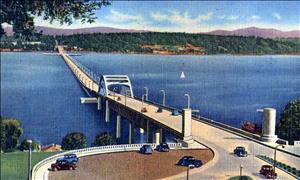Beginning at 11:15 a.m. on July 2, 1940, dedication ceremonies are held for the Lake Washington Floating Bridge (also called Mercer Island Bridge). The bridge carries US 10 (later decommissioned and renamed Interstate 90) across the lake from the Mount Baker neighborhood of Seattle over Mercer Island to a point south of Bellevue. It is at the time the largest floating structure ever built, and the first to cross Lake Washington. In 1967 the Lake Washington Floating Bridge will be renamed the Lacey V. Murrow Memorial Bridge.
The dedication went off with great fanfare. Two thousand people attended on the east side of the bridge. A ribbon was cut, and an urn containing water from 58 Washington streams and lakes was smashed against the side of the bridge. The Seattle Breakfast Club enjoyed its repast under the west approach, and an Army band played. Later there were swimming races, fancy diving, surf boarding, and water skiing exhibitions.
The bridge, first conceived by engineer Homer Hadley (1885-1967) in 1921, floats on hollow concrete pontoons, which was at the time of its construction was an innovative technology. It was the world's largest floating structure and cost $8,854,000 to build.
Governor Clarence D. Martin paid the first toll to cross the bridge. Toll charges mostly applied to automobiles but included 35 cents for wagons drawn by one or two horses and 50 cents for wagons drawn by three or more horses. The bridge saved up to an entire hour of commuting time to Seattle.
The bridge had a sliding draw part (a bulge) that required traffic to make a sharp turn at high speeds. Because of this bulge, the bridge became notorious for accidents, some fatal. In 1981, the Washington State Department of Highways replaced the bulge with straight pontoons. In 1989 a parallel twin bridge, the Homer Hadley Bridge, was completed.
On November 25, 1990, during a storm, the bridge sank. It had been under repair and bridge workers had left open the hatchways to the hollow pontoons, which filled with water during the storm. The bridge was later rebuilt.

